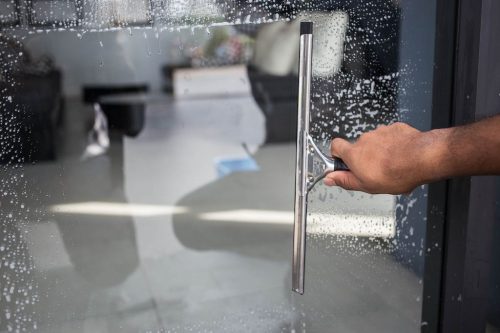6 easy steps to achieve clean, streak-free windows.

Before starting your window-washing project, make sure you have the following supplies on hand:
- Bucket
- Dish soap
- White vinegar
- Spray bottle
- Squeegee wet and dry covers
- Steel wool
- Microfiber cloth (or lint-free towel)
- Vacuum (optional)
- Paper towels
- Distilled water
Pro tip: You don’t need to spend a lot of money on a “streak-free” commercial cleaner for your dirty windows. A homemade, DIY solution that contains dish soap and warm water will do the trick. You can also make a glass cleaner using white vinegar and water.
You have your window-cleaning solution, bucket and supplies in hand. Here’s how to clean dirty glass windows and achieve a spotless, streak-free shine:
Step 1: Remove dust and dirt.
Before you start washing your windows with your cleaning solution, do your best to get rid of all the dust and dirt that’s accumulated on and around the glass. Remove dirt from your window frames with a handheld vacuum or a lint-free cloth. Get rid of grime around the outside of your windows with a hose.
Step 2: Prep your cleaning solution in a bucket — and use a spray bottle.
Don’t be fooled. Cleaning your windows is more about putting in the time and elbow grease than buying the right window-washing products. Experts will tell you that a homemade mixture of dishwashing liquid and warm soapy water will leave your window just as streak-free and shiny as that name-brand stuff.
While you’re mixing your bucket, prep a spray bottle with equal parts white vinegar and water to give problem areas a second pass.
Step 3: Clean the windows with a squeegee wet cover.
Squeegee wet covers are best for large windows — especially on hot days when the solution will dry fast. To avoid doubling your work, only clean windows when they’re not in direct sunlight (more on that later).
Dip the squeegee into soapy water, wring out any excess water and wipe down the whole window, including corners. You should see a soapy residue on the surface of the glass. If you don’t — or if you hear squeaks — it’s a sign you need more soap in your solution.
Clean windows one pane at a time. If suds land on an already clean window, dry them off right away using a microfiber cloth.
Step 4: Remove soap and water off with a dry squeegee.
Remove the wet cover from the squeegee, and use the rubber blade to clean and dry the windows. If you’re dealing with a series of small window panels, use the squeegee vertically, from the top of the window to the bottom. If the window is larger, remove water in overlapping horizontal strokes, stopping to wipe your squeegee off with a paper towel (or other lint-free cloth) every other stroke.
Use an old towel or cloth diaper to catch any excess water collecting on window sills.
Step 5: Spot clean your windows.
Spot clean the window and remove any drips or streaks using the white vinegar-water solution you made earlier.
Step 6: Remove hard water stains and water spots from the glass.
Lifting hard water stains off a glass surface generally takes more than water and dish soap. Some window cleaners use steel wool to scrub mineral buildup off windows. Wet the steel wool, and go back to already-clean windows and work your way over problem areas in small circles.
Pro tip: You can also remove water spots from windows with white vinegar and water, or baking soda and water.
See more at…https://www.thumbtack.com/guide/content/how-to-clean-your-windows-